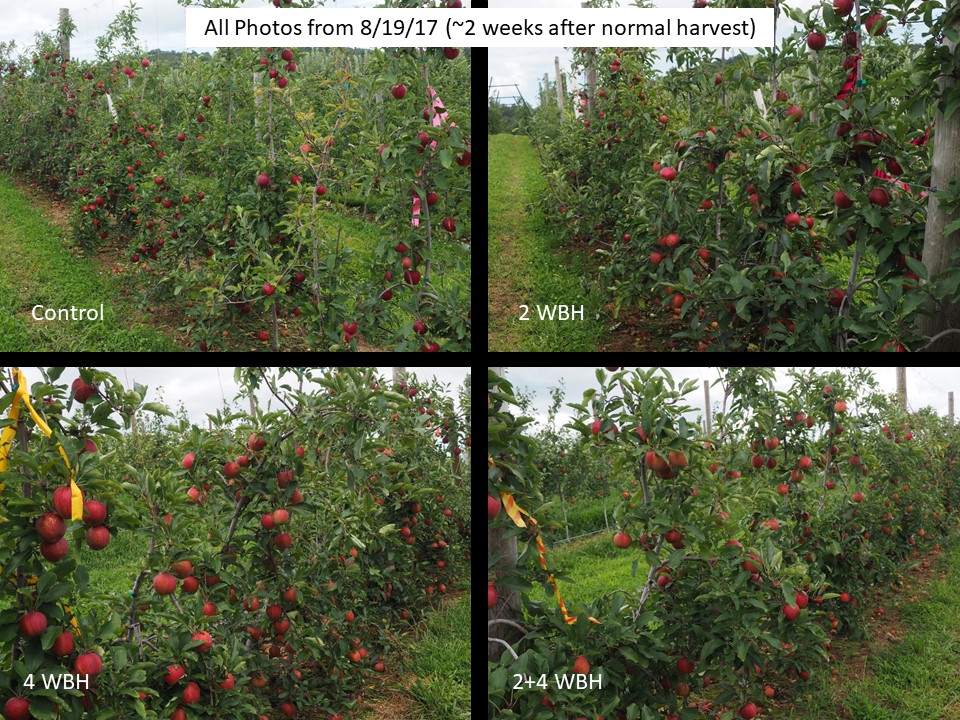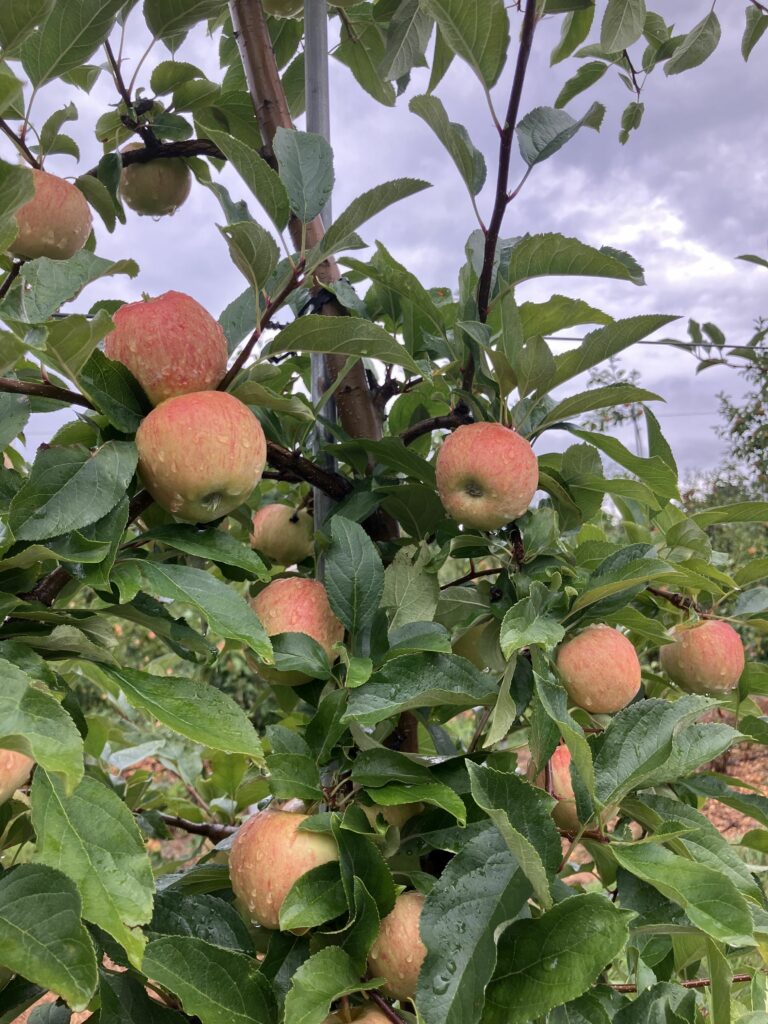2024 Apple Harvest Management Considerations: Special Focus on Gala
go.ncsu.edu/readext?1014997
en Español / em Português
El inglés es el idioma de control de esta página. En la medida en que haya algún conflicto entre la traducción al inglés y la traducción, el inglés prevalece.
Al hacer clic en el enlace de traducción se activa un servicio de traducción gratuito para convertir la página al español. Al igual que con cualquier traducción por Internet, la conversión no es sensible al contexto y puede que no traduzca el texto en su significado original. NC State Extension no garantiza la exactitud del texto traducido. Por favor, tenga en cuenta que algunas aplicaciones y/o servicios pueden no funcionar como se espera cuando se traducen.
Português
Inglês é o idioma de controle desta página. Na medida que haja algum conflito entre o texto original em Inglês e a tradução, o Inglês prevalece.
Ao clicar no link de tradução, um serviço gratuito de tradução será ativado para converter a página para o Português. Como em qualquer tradução pela internet, a conversão não é sensivel ao contexto e pode não ocorrer a tradução para o significado orginal. O serviço de Extensão da Carolina do Norte (NC State Extension) não garante a exatidão do texto traduzido. Por favor, observe que algumas funções ou serviços podem não funcionar como esperado após a tradução.
English
English is the controlling language of this page. To the extent there is any conflict between the English text and the translation, English controls.
Clicking on the translation link activates a free translation service to convert the page to Spanish. As with any Internet translation, the conversion is not context-sensitive and may not translate the text to its original meaning. NC State Extension does not guarantee the accuracy of the translated text. Please note that some applications and/or services may not function as expected when translated.
Collapse ▲Across most of the region, a relatively large crop of apples is expected in 2024. While crop load and fruit finish are a bit hit or miss, fruit size is respectable across many cultivars and orchards. At present, growing degree day accumulation (base 50) in Mills River, NC is 240 hours greater than the 41 year average (Figure 1).

Figure 1. Growing degree day accumulation (base 50) in Mills River, NC is 240 hours greater than the 41 year average as of 17 July 2024. Data and figure courtesy of the NC Climate Office.
This suggests that apple harvest will start earlier than normal, which complicates harvest management decisions and logistics. The use of plant growth regulators to manage harvest will be important for many southeastern commercial apple growers this season.
For an overview of possible plant growth regulators, application rates, and timings used for apple maturity and preharvest drop management please see an article we (Dr. Jimmy Larson and I) wrote in 2022: Using PGRs to Manage Apple Preharvest Drop, Fruit Maturity, and Harvest Timing.
The remainder of this article will focus on potential ReTain® application patterns for Gala in the southeastern US. I have received several questions about this recently, especially with unsettled weather patterns predicted over the next 7 to 10 days. Many would like to be applying ReTain® during this interval, but it may be challenging to find a gap in the weather.
Gala remains an important cultivar for many southeastern apple growers. Gala is not prone to preharvest drop and is sensitive to ReTain® (i.e. responses are observed at lower rates than most other cultivars). However, there are three primary reasons to consider use of plant growth regulators for harvest management of Gala:
- To stagger harvest timing for labor management and/or to hit specific markets
- To minimize the incidence of stem-end splitting
- To improve fruit size
Our research program conducted a fair amount of research with ReTain® on Gala in the southeast over the past 7 years. While not gospel, here are some things to consider with ReTain® and Gala in 2024.

Figure 2. Stem-end splitting is a physical defect that can cause yield losses in several commercially important apple varieties (Gala, Fuji, Honeycrisp, etc.). Several factors are strongly associated with stem-end splitting, including: heavy rainfall proximal to harvest, high sunlight exposure, rapid fruit growth rates, large fruit size, and advanced fruit maturity.
When to apply in a year with advanced maturity?
Early season apple varieties (harvested in July and August in the southeastern region) are more prone to changes in harvest date due to environmental conditions than later ripening varieties. Gala would certainly fall into this category.
In years with advanced maturity (such as 2024), this needs to be considered when scheduling ReTain® applications. Here is an example:
- A typical 1st harvest date for Gala in Mills River, NC is ~August 9th
- If the season is running ~7 days early (based on observations from other early apple cultivars or peaches), then the anticipated date of harvest would be August 2nd
- The anticipated harvest date (August 2nd in this example) should be used when scheduling retain applications
Across most varieties, a typical recommended timing for ReTain® application is 3 to 4 weeks before anticipated harvest. However, with Gala, in warm years where maturity is advanced, consider making applications closer to 2 weeks before anticipated harvest. Growers and researchers across the eastern US have observed that in warmer years with advanced maturity, early applications of ReTain® (4 weeks before anticipated harvest) were less effective than applications closer to harvest.
What rates and timings should I use?
This really depends on the objective(s) of the application – ReTain® use patterns are not one-size-fits all.
ReTain® is a dose dependent product and has a relatively wide range of effective rates that can be used. As you increase the rate, the amount of time that fruit maturity is delayed is also increased. Many factors can influence the timing of maturity….but assuming an application date of 3 weeks before anticipated harvest, good tree health, moderate crop load, and “normal” environmental conditions here is a rough proxy on Gala (***Please Note*** these are just rough estimates and may not pertain to your specific situation):
- ½ pouch will delay maturity by ~ 3 to 7 days
- “Heavy half” (3 pouches in a 500 gallon tank) will delay maturity by ~7 to 10 days
- 1 pouch (333 g per acre) will delay maturity by ~ 2 to 3 weeks
- 2 pouches (666 g per acre) will delay maturity > 3 weeks
For Gala, the strain is also important in determining ReTain® rates and timings. Concerns regarding impacts on red fruit color development are warranted with poor coloring strains. In this case, lower rates and applications closer to harvest are typically suggested to minimize impacts on red fruit color development.
Poor coloring strains
- The ½ to 1 pouch rates should only be considered on poorly colored strains (Tenroy, Imperial, Pacific, etc.) of Gala to minimize effects on delayed color development. In general, the ½-pouch rate will not delay maturity by more than 7 days and has not been effective in minimizing stem end splitting.
- If you have a poorly colored strain and want to reduce the incidence of stem-end splitting, then I would consider using 1-pouch per acre at 7 to 10 days before anticipated harvest. This application will not influence the timing of the 1st harvest but will influence fruit maturity of fruit that are destined for later harvests. Even with this application being so close to harvest, we still observed a significant reduction in stem-end splitting on Gala.
Highly colored strains
There are multiple strains of Gala that have improved red color and can achieve greater than 80% coverage of marketable blush (deep red fruit color), even in warm climates (examples include: Buckeye®, Ultima™, Gale®, Brookfield®, etc.). With improved red fruit color development, there is not as much concern related to the delay in red color development. As a result, growers can use the full range of application rates on highly colored strains, if of interest.
In addition to the use patterns described above, to further delay maturity (i.e., to obtain maximum benefits of increased fruit size and/or staggering harvest date) a double rate can be applied.
To illustrate this point, we conducted a small research and demonstration plot at a grower orchard in 2017. This was done on mature ‘Ultima™ Gala’ in a tall spindle orchard. Treatments were as follows:
- untreated control (doing nothing)
- 2 pouches of Retain® at 2 weeks before anticipated harvest
- 2 pouches of Retain® at 4 weeks before anticipated harvest
- 1 pouch at 4 WBAH + 1 pouch at 2 weeks before anticipated harvest
At 2 weeks after anticipated harvest, all treatments had sufficient red fruit color development (>50% of the fruit surface coverage with marketable blush; Figure 3).

Figure 3: Improved strains of Gala permit use of higher rates of ReTain to manage fruit maturity without concerns related to delayed red fruit color development. By two weeks after anticipated harvest, fruit had sufficient red fruit color development to meet market standards.
As expected and desired, fruit maturity (firmness, starch pattern index, soluble solids concentration) was delayed with all double pouch programs (Figures 4, 5, and 6).
Notably, fruit size increased across sampling dates and stem end splitting was dramatically reduced with the double pouch programs evaluated.
Should I use a single application or a split application?
Both approaches are fine. As long as they are timed appropriately, single applications are just as effective as split applications (see the trial highlighted above). Some prefer to use the split application to have additional flexibility in harvest management decisions. Others prefer to save the extra trip through the orchard.
What if it rains shortly after I apply ReTain®?
Given the expense of this product, this is a bummer. However, if the material had sufficient time to dry then you will get most of the benefit of the application. Always shoot for at least 6 hours of drying time where possible. Very light rain/mist following application is not a serious concern and may actually increase uptake and activity.
General considerations
- ReTain® should be applied as a separate spray.
- A 100% organosilcone surfactant at 0.05 to 0.1 % v/v (6.4 to 12.8 fl. oz. per 100 gallons) should be used with ReTain®. During periods of hot weather, it is recommended to use the low organosilcone surfactant rate (6.4 fl. oz. per 100 gallons) to avoid issues with phytotoxicity.
- Aim for application(s) of ReTain® during slow drying conditions and when there is at least 6 hours of drying time. Avoid applications during the heat of the day.
- The REI for ReTain® is 12 hours; the PHI is 7 days.
For more information see:
https://www.valentbiosciences.com/wp-content/uploads/2022/08/Retain_Tech-Manual_Web.pdf
https://ag.umass.edu/sites/ag.umass.edu/files/news/pdf/retain_recommendations_2022.pdf
https://nyshs.org/wp-content/uploads/2014/09/Schwallier-Pages-15-18-NYFQ-Fall-2014-Book-4.pdf






